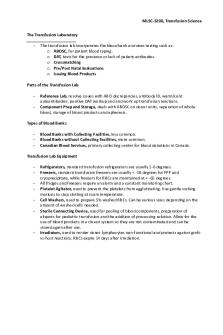Pediatrics Intro to D&D PDF

| Title | Pediatrics Intro to D&D |
|---|---|
| Author | Magdalena Sadowska |
| Course | D&D |
| Institution | St. John's University |
| Pages | 6 |
| File Size | 141.6 KB |
| File Type | |
| Total Downloads | 80 |
| Total Views | 171 |
Summary
more peds...
Description
Intro to Pediatrics Introduction Pediatric pharmacy focuses on the provision of drug therapy to infants, children and adolescents o Pharmacists who care for pediatric patients should possess knowledge regarding disease states along with drug therapy o Pediatric patients are not simply “small adults” Pediatric Pharmacists How do you become a pediatric pharmacist? o Pediatric focused PGY-1 o Adult focused PGY-1 with peds focused PGY-2 o PGY-1 with joint peds and adult focus, plus pediatric experience The Basics Few clinical trials o 1/3 of FDA approved medication have pediatric labeling o 2 SDS Below average Zika Pediatric Vital Signs Respiratory rate and heart rate are higher than in the adults Blood pressure are lower than in the adults During early adolescents the vitals change more to adults Pharmacokinetics Pharmacokinetics (PK) is the study of the time course of drug disposition within the body PK is described by ADME principles o Pediatric PK doesn’t not equal Adult PK o Absorption PO absorption is dependent on many factors Theses factors undergo significant changes as a neonate grows into an adult Decreased gastric motility Decreased bile salt production Decreased pancreatic enzyme activity Decreased gastric pH
o
o
Topical
Decreased/ increased GI bacterial flora
Pediatric patients: o Decreased thickness of stratum corneum o Increased skin hydration o Increased body surface are to body weight ratio Clinically: o Increased skin absorption o Increased systemic absorption More water content in the body 80% water content in children 50-60% of adults Intramuscular Decreased skeletal muscle blood flow o Decreased rate of absorption Vaccinations are used but prefer to a IV Can cause pain o Mix with lidocaine to decrease the long term soreness Inhalation Altered structure and capacity of lungs o Increased systemic absorption of drugs Rectal Decreased hepatic metabolism o Increased bioavailability of hepatically metabolized drugs Increased contractions in the rectum o Decreased absorption due to expulsion of dosage form When cant handle PO or vomiting Acetaminophen is given to children less than 1 yr old IV Most effective and reliable method of drug absorption Distribution Volume of distribution (VD) Body composition changes with age Total body water o Increased in younger patients: increase volume of distribution for water soluble drugs Adipose tissue o Neonates and children have less adipose tissue (percentage of body weight) as compared to adults Full term neonate: 12-16% of body weight is adipose tissue o Decrease volume of distribution for fate soluble drugs Plasma proteins o Decreased amount and altered structure in neonates and children Increased amount of unbound drug (active drug) o Certain drugs compete for binding sites Some medication (i.e. antibiotics such as Bactrim) displace bilirubin on albumin Membrane permeability o Increased permeability into the CNS o Increased distribution of drugs across the blood brain barrier Bilirubin = jaundice Can use a UV light to break up the bilirubin Yellow breakdown product of hemoglobin Eliminated in the bile and urine Lipophilic Heavily albumin-bound Highly neurotoxic Kernicterus Hyperbilirubinemia-induced neurologic damage o Can be irreversible Incidence increases when serum bilirubin >25 mg/dL ( normal 99 mg/kg Symptoms: multi-organ failure, severe metabolic acidosis, gasping respirations Should not use medications with benzyl alcohol as a preservative o Use preservative-free if available
Elimination Starting in fetal development, renal function is continuously changing as we age Glomerular filtration rate (GFR) is significantly reduced at birth Preterm neonate GFR: 0.6-0.8 mL/min/1.73 m2 Term neonate GFR: 2-4 mL/min/1.73 m2 GFR reaches normal adult values between 9-12 months old Must consider renal maturation when dosing renally eliminated medications Decreased GFR can result in decreased renal clearance, increased drug accumulation and potential drug toxicities Estimating renal function Cockroft- gault = adults Schwartz= pediatrics Creatinine values are higher .8-1.2 adult and babies can show higher because they show a reflection of the mothers Normal = .2-.3 Renal function = urine output Measuring diapers GFR will reach adult value at 1 yr Creatinine alone doesn’t show the renal function the best ...
Similar Free PDFs

Pediatrics Intro to D&D
- 6 Pages

Pediatrics - Ophthalmology
- 1 Pages

Intro to textiles
- 8 Pages

Intro to Med Term
- 41 Pages

Intro to Tinker CAD
- 3 Pages

Intro to Oscilloscopes
- 8 Pages

Intro to Sociology
- 34 Pages

Intro to Transfusion Science
- 3 Pages

Intro to computational physics
- 3 Pages

Intro to marketing syllabus
- 19 Pages

Intro to Corp Finance
- 55 Pages

Intro to Python Worksheet
- 9 Pages

Intro to lids wheel
- 5 Pages

Intro to Journalism Handbook
- 6 Pages

K14 - intro to kinesiology
- 3 Pages
Popular Institutions
- Tinajero National High School - Annex
- Politeknik Caltex Riau
- Yokohama City University
- SGT University
- University of Al-Qadisiyah
- Divine Word College of Vigan
- Techniek College Rotterdam
- Universidade de Santiago
- Universiti Teknologi MARA Cawangan Johor Kampus Pasir Gudang
- Poltekkes Kemenkes Yogyakarta
- Baguio City National High School
- Colegio san marcos
- preparatoria uno
- Centro de Bachillerato Tecnológico Industrial y de Servicios No. 107
- Dalian Maritime University
- Quang Trung Secondary School
- Colegio Tecnológico en Informática
- Corporación Regional de Educación Superior
- Grupo CEDVA
- Dar Al Uloom University
- Centro de Estudios Preuniversitarios de la Universidad Nacional de Ingeniería
- 上智大学
- Aakash International School, Nuna Majara
- San Felipe Neri Catholic School
- Kang Chiao International School - New Taipei City
- Misamis Occidental National High School
- Institución Educativa Escuela Normal Juan Ladrilleros
- Kolehiyo ng Pantukan
- Batanes State College
- Instituto Continental
- Sekolah Menengah Kejuruan Kesehatan Kaltara (Tarakan)
- Colegio de La Inmaculada Concepcion - Cebu
